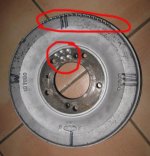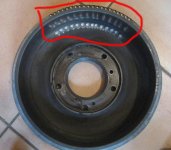Some random musings
just for fun: Since the scuttle shake seems to occur at 55-60 mph on most reported cars, this would seem to be a resonance condition. Since it seems to be tied to vehicle speed rather than engine rpm or gear position (driveline rpm), one might conclude that it is a resonance in the structure that is excited somehow by a rotating component in the wheel/tyre system that passes thru that particular frequency and lights off the scuttle shake.
I did a rough calculation on this. At 60 mph, I assumed the OD of the tyre is about 26 inches. A once per rev imbalance in the tyre or brake drum would give a forcing frequency of 13.5 Hz at 60 mph. Although I haven't measured the frequency of the scuttle shake, this 13 Hz frequency makes some general sense to me. Others may report that it feels like a lower frequency than that.
U-joints generate a 2 per rev excitation, and the 6 cyl engine generates a fundamental at 3 times per rev (firing frequency). The engine firing frequency would excite the 13 Hz resonance at around 13 = x rpm/60 * 3. So x would be 260 rpm. 2nd or 3rd harmonic of the engine firing could come into play, but that would still be low in rpm. 60 mph in a Healey is usually up above 2000 rpm.
U-joints would then be at 390 driveline rpm. I think ...........
There are 2 general approaches to resolving a structural resonance issue: 1) shift the mode up or down out of the operating range with mass and/or stiffness changes (bracing the cowl) or 2) reducing the forcing function (the hammer that is hitting the system), such as balance improvement. Actually, 3 things

Increase damping in the system, but that is out of the scope of this discussion.
The resonant mode we are talking about here could be some combination of structural interaction. Frame and chassis. Bracing the cowl could just be the easiest, most effective solution found emperically back in the day.
This is why race cars want to have very light and stiff chassis - no unexpected inputs to the driver that aren't coming from the road.
my 2 cents.

 Hi Guest!
Hi Guest!

 smilie in place of the real @
smilie in place of the real @
 Pretty Please - add it to our Events forum(s) and add to the calendar! >>
Pretty Please - add it to our Events forum(s) and add to the calendar! >> 



